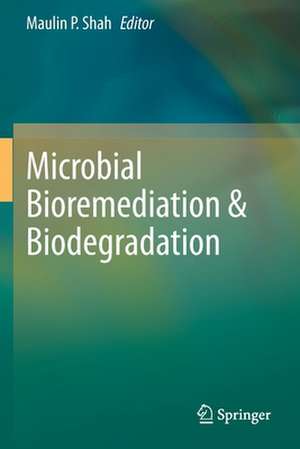Microbial Bioremediation & Biodegradation
Editat de Maulin P. Shahen Limba Engleză Paperback – mai 2021
| Toate formatele și edițiile | Preț | Express |
|---|---|---|
| Paperback (1) | 1392.65 lei 6-8 săpt. | |
| Springer Nature Singapore – mai 2021 | 1392.65 lei 6-8 săpt. | |
| Hardback (1) | 1398.94 lei 6-8 săpt. | |
| Springer Nature Singapore – mai 2020 | 1398.94 lei 6-8 săpt. |
Preț: 1392.65 lei
Preț vechi: 1698.34 lei
-18% Nou
Puncte Express: 2089
Preț estimativ în valută:
266.52€ • 277.22$ • 220.03£
266.52€ • 277.22$ • 220.03£
Carte tipărită la comandă
Livrare economică 14-28 aprilie
Preluare comenzi: 021 569.72.76
Specificații
ISBN-13: 9789811518140
ISBN-10: 9811518149
Ilustrații: IX, 550 p. 69 illus., 48 illus. in color.
Dimensiuni: 155 x 235 mm
Greutate: 0.78 kg
Ediția:1st ed. 2020
Editura: Springer Nature Singapore
Colecția Springer
Locul publicării:Singapore, Singapore
ISBN-10: 9811518149
Ilustrații: IX, 550 p. 69 illus., 48 illus. in color.
Dimensiuni: 155 x 235 mm
Greutate: 0.78 kg
Ediția:1st ed. 2020
Editura: Springer Nature Singapore
Colecția Springer
Locul publicării:Singapore, Singapore
Cuprins
Chapter 1. Bioremediation Approaches for Treatment of Pulp and Paper Industry Wastewater: Recent Advances and Challenges.- Chapter 2. Microbial remediation of Heavy Metals.- Chapter 3. Dyes: Effect on the Environment and Biosphere and Their Remediation Constraints.- Chapter 4. Microbial Bioremediation and Biodegradation of Hydrocarbons, Heavy Metals, and Radioactive Wastes in Solids and Wastewaters.- Chapter 5. Advancement of Omics: Prospects for Bioremediation of Contaminated Soils.- Chapter 6. Microbial Biotransformation of Hexavalent Chromium [Cr(VI)] in Tannery Wastewater.- Chapter 7. Bioremediation: A Low-Cost and Clean-Green Technology for Environmental Management.- Chapter 8. Microbial Degradation of Pharmaceuticals and Personal Care Products from Wastewater.- Chapter 9. Extremophiles: A Powerful Choice for Bioremediation of Toxic Oxyanions.- Chapter 10. Conventional and Nonconventional Biodegradation Technologies for Agro-IndustrialLiquid Waste Management.- Chapter 11. White Rot Fungi: Nature’s Scavenger.- Chapter 12. Nanobioremediation: An Emerging Approach for a Cleaner Environment.- Chapter 13. Bioelectrochemical System for Bioremediation and Energy Generation.- Chapter 14. Ligninolysis: Roles of Microbes and Their Extracellular Enzymes.- Chapter 15. Biosorption of Heavy Metals by Cyanobacteria: Potential of Live and Dead Cells in Bioremediation.- Chapter 16. Bioremediation of pharmaceuticals in water and wastewater.- Chapter 17. Bioremediation Of Saline Soil by Cyanobacteria.- Chapter 18. Advancement in Treatment Technologies of Biopharmaceutical Industrial Effluents.-Chapter 19. Marine Bacteria: A Storehouse of Novel Compounds for Biodegradation.- Chapter 20. Energy-Efficient Anaerobic Ammonia Removal: From Laboratory to Full-Scale Application.- Chapter 21. Microbial Degradation of Natural and Synthetic Rubbers.-
Notă biografică
Dr. Maulin Shah received his Ph.D. (2002–2005) in Environmental Microbiology from Sardar Patel University, Vallabh Vidyanagar, Gujarat. He has served as an Assistant Professor at Godhra, Gujarat University, in 2001. He has edited 25 books in the area of wastewater microbiology.
Textul de pe ultima copertă
Microbial or biological degradation has long been the subject of active concern, and the rapid expansion and growing sophistication of various industries in the last century has significantly increased the volume and complexity of toxic residues of wastes. These can be remediated by plants and microbes, either natural origin or adapted for a specific purpose, in a process known as bioremediation. The interest in microbial biodegradation of pollutants has intensified in recent years in an attempt to find sustainable ways to clean contaminated environments. These bioremediation and biotransformation methods take advantage of the tremendous microbial catabolic diversity to degrade, transform or accumulate a variety of compounds, such as hydrocarbons, polychlorinated biphenyls, polaromatic hydrocarbons pharmaceutical substances, radionuclides and metals. Unlike conventional methods, bioremediation does not physically disturb the site. This book describes the basic principles of biodegradation and shows how these principles are related to bioremediation. Authored by leading, international environmental microbiologists, it discusses topics such as aerobic biodegradation, microbial degradation of pollutants, and microbial community dynamics. It provides valuable insights into how biodegration processes work and can be utilised for pollution abatement, and as such appeals to researchers and postgraduate students as well as experts in the field of bioremediation.
Caracteristici
Highlights the current state and importance of environmental bioremediation & biodegradation Introduces emerging trends and advances in environmental bioremediation & biodegradation Presents updated vision of the existing bioremediation strategies with their limitations and challenges
